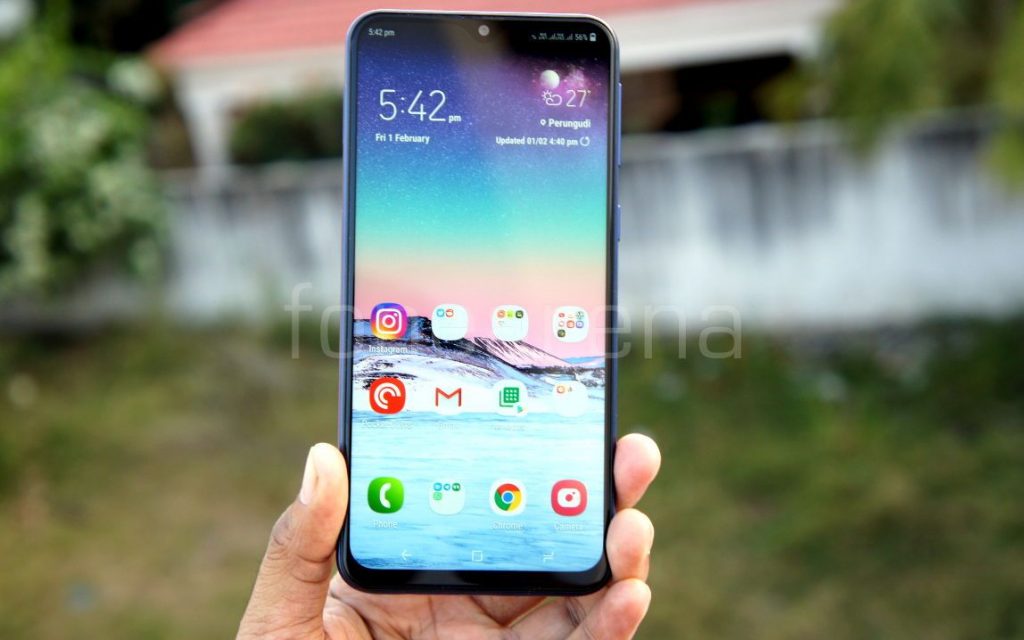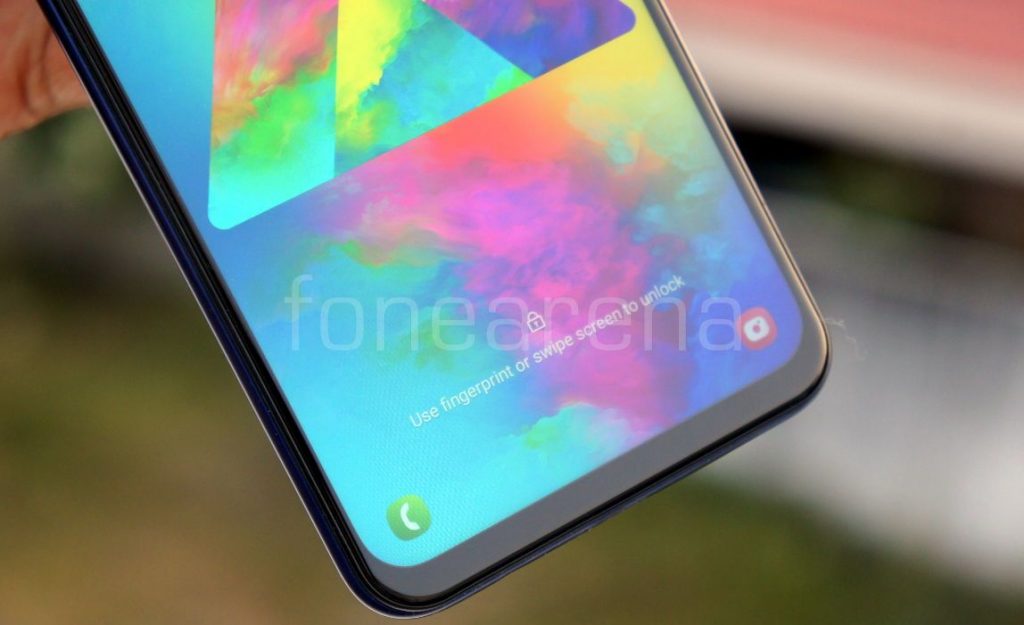
Samsung launched the new Galaxy M10 and Galaxy M20 smartphones in the new ‘M Series’ in India last week. Here we have the review of the M20 smartphone, which is the bigger version of the two packing a large 6.3-inch Full HD+ screen and a huge 5000mAh battery with fast charging. Specifications look great on paper, is the phone worth the price of Rs. 10,999? Let us dive into the review to find out.
Box Contents

- Samsung Galaxy M20 smartphone in Ocean Blue color
- SIM Ejector Pin
- 2-pin 15W (9V-1.67A / 5V-2A) fast charger
- USB Type-C Cable
- Quick Start Guide and Warranty information
Display, Hardware and Design

The new Galaxy M20 comes with a 6.3-inch Full HD+ Infinity V display with a resolution of 1080×2340 pixels at about 409 PPI, aspect ratio of 19.5:9 and a screen-to-body ratio of about 84%, better than most other mid-range Samsung smartphones. Even though this uses TFT LCD screen, the display looks bright, offers good color reproduction and the sunlight legibility is good as well, however it can’t match AMOLED displays that offer better color reproduction and true blacks. However, you can’t expect AMOLED screen in the price range. The phone doesn’t have Corning Gorilla Glass protection, and the company doesn’t say if the phone comes with any kind of hardened glass for protection against scratches.
Similar to most phones with a notch, this has option to hide the notch, and an option to select apps you want to use in full screen. Due to the aspect ratio content doesn’t extend to the sides of the phone when you are watching normal 16:9 videos. If you want it to extend to the sides, you have to pinch the screen to fill the content. If you are watching a video in 21:9 aspect ratio, which has the benefit of removing black bars on the top and bottom of screens, the software stretches the image to fit the 21:9 format and allows you to watch the video as it more naturally.
Similar to the other top-end Samsung phones, there is Blue light filter that is said to reduce eye strain by limiting the amount of blue light emitted by the screen, but option to schedule Blue light filter is not available, which is a bummer. You can’t adjust the screen resolution like the S8 and Note8 phones, but change font size and style and select apps that you want to use in the full screen aspect ratio. It doesn’t have notification LED and also lacks Always on display that is available on its phones with AMOLED displays, so you won’t know if there’s new notification when the screen if off. You can enable lockscreen notifications that shows up on the lock screen.

On the top, there is an 8-megapixel camera in the notch and the earpiece is present on the top edge. There is also a tiny space in the top left corner for the proximity sensor. Even though the CPU-Z doesn’t show an ambient light sensor, there is auto brightness adjustment, and Samsung’s user manual says there is one along with the proximity sensor. Automatic brightness adjustment takes a bit of time to adjust to the surrounding environment. The phone has gyroscope and magnetic sensor, otherwise known as magnetometer for VR, but it doesn’t have a notification LED.

There is a small chin below the screen, similar to most phones with a notch, however this is smaller compared to the Galaxy M10.
The phone has shiny plastic frame which feels a bit cheap, however it doesn’t slip out of your hands easily. On the right side, there is a power button and the volume rockers. On the left side there is a single tray that houses dual nano SIM slots and a microSD card slot that accepts cards up to 512GB. At the bottom, there is a 3.5mm audio jack, USB Type-C port, loudspeaker grill and the primary microphone.

It is a good thing that Samsung has provided dedicated dual SIM and microSD card slots when there are a lot of phones that come with hybrid SIM arrangement.

On the back, there is a 13-megapixel primary sensor with f/1.9 aperture, secondary 5-megapixel 120° Ultra Wide Lens for wide-angle photos. There is a single LED flash below the camera module, and a fingerprint sensor next to it.

Even though the phone has a huge 6-inch screen, it is compact to hold. It measures 156.4 x 74.5 x8.8mm, which is smaller than the A7 (2018). It weighs 186 grams since it has a huge 5000mAh battery. The plastic back doesn’t attract fingerprints, but it is prone to scratches on day-to-day use. It is recommended to get a case since Samsung doesn’t provide one in the box.
Camera

It has a 13-megapixel rear camera with 1/3.1″ Samsung S5K3L6 ISOCELL Fast sensor, 1.12μm pixel size and f/1.9 aperture, PDAF along with a 5-megapixel 120-degree ultra-wide lens with f/2.2 aperture. It has an 8-megapixel camera on the front with f/2.2 aperture. Since this comes with an 120° Ultra Wide Lens, you can switch between the normal 78-degree Field Of View main camera and 120-degree Field Of View wide-angle camera easily.
Even though there is Live Focus, this uses software to blur the background in the images since the wide-angle sensor cannot be used for it. The software blur works only on the face, and not for objects. Unlike Samsung phones with depth sensor, this doesn’t let you adjust the bokeh effect before or after the shot. There is selfie portrait option for the front camera that also uses software to blur the background.
It has Auto mode, Panorama, Pro, Beauty as well as Pro mode to adjust ISO, Shutter speed, focus, white balance and exposure manually. It also has AR stickers that lets you add stickers.
Coming to the image quality, daylight shots are good, and the camera captures a good amount of detail, creates well exposed photos with good dynamic range and detailing, and dynamic range can further be improved enabling HDR mode from the settings. The autofocus speeds are fast and accurate. Macro shots are good as well. Live focus is not the best in detecting the edges since it is done by the software, and the wide-angle lens is useful in several places. Even though the edges look a bit curved due to the lens, but the ‘Shape Correction’ option in the gallery lets you fix it. Low-light performance is just average, and there is a lot of noise. Images with flash is good even in closeups and is not over powering.
The 8-megapixel front camera is decent when there is enough light. Since there is no flash on the front, you can’t expect good indoor performance. Again the software blur in the live focus mode struggles to detect the edges.
Check out some camera samples (Click the image for the full resolution sample).





Check out more samples here. It can record videos at maximum 1080p resolution at 30 fps. Video quality is decent, and the audio crisp since it has a secondary microphone. Check out the video sample below.
Software, UI and Apps
Coming to the software, the phone runs on Android 8.1 (Oreo) with Android security patch for January 2019. Samsung has not announced when the phone will get Android Pie update. On the top of Oreo, it has Samsung Experience version 9.5, which is the company’s new UX that is more refined compared to its TouchWiz UX. Other than the familar features that we had seen in the Samsung Experience UX, this has a new lockscreen stories powered by glace which shows news along with an image before you unlock the phone. You can choose from 19 categories, with daily digest being the default. It doesn’t have Bixby home that is present in most Samsung phones.
The advanced features option has Games Launcher that gathers your games downloaded from Play Store and Galaxy Apps into one place for easy access, one-handed operation mode that lets you use the phone easily with one hand, finger sensor gestures to open and close the notification panel using the fingerprint sensor, multi window, direct call to make a voice call by picking up and holding the device near your ear while viewing call, message, or contact details, Smart alert to set the device to alert you if you have missed calls or new messages when you pick up the device, Easy mute to mute incoming calls or alarms by using palm motions or facing the device’s screen downwards, Panic mode to Send SOS message by pressing the Power key three times and more.
The Device maintenance option lets you manage your device’s battery life, storage, RAM usage, and security all in one place.
Apart from the usual set of utility apps and Google Apps, the smartphone comes with Facebook app and Microsoft Apps — Office Mobile, OneDrive and LinkedIn. You get option to install apps when you are setting up the phone.
Out of 4GB of RAM, you get 3.7GB of usable RAM, out of which about 1.9GB of RAM is free when the default apps running in the background. Out of 64GB of internal storage, about 51GB of storage is usable.
Fingerprint Sensor and Face unlock
The fingerprint sensor is present on the back, similar to most Samsung phones. It immediately unlocks phone just by keeping your finger so that you don’t have to press it. You can add up to 3 fingerprints, and adding fingerprint is easily with few swipes. It has support for Face recognition, which doesn’t work well if the lighting is poor in the room, if you are wearing glasses, hats, or use heavy makeup. But it is quick to unlock the phone.
Music Player and FM Radio
Google Play Music is the default music player. It has equalizer, Dolby Atmos, UHQ upscaler, Surround and Tube Amp Pro sound effects that can be enabled from the settings. All these improve the audio when listening through earphones. It has FM Radio support with support for recording. That said, audio through third-party headphones is good. Loudspeaker output from the mono speaker is good as well.
Dual SIM and Connectivity
The connectivity options include, Wi-Fi 802.11 b/g/n, Bluetooth v5 and GPS with GLONASS. It has support for USB OTG. It has 4G connectivity with support a lot of bands and has Voice-over-LTE (VoLTE) support for Reliance Jio, Airtel and more. It also has dual 4G VoLTE support, which is good. The dialer and messaging have familiar UI. Since this is a dual SIM phone, you get option to select either SIMs when calling or sending text message. Moving on, the call quality is good, and we did not face any call drops and the earpiece volume was loud.
Performance and Benchmarks

It is powered by the new Exynos 7904 octa-core 14nm processor in the Galaxy M20 It has two bigger ARM Cortex-A73 CPUs clocked at 1.8GHz power core and the six smaller ARM Cortex-A53 CPUs are clocked at 1.6GHz per core. It has Mali-G71 MP2GPU and has support for LPDDR4x memory. As you can see the scores, it is clear that the new SoC is better than the Snapdragon 625, Snapdragon 632 and Snapdragon 450 SoCs that some offer in the price range, however the Snapdragon 636 has a slight edge over the Exynos 7904 since it uses of four Kryo 260 that has custom ARM Cortex A73-based cores.
Talking about the real world experience, the performance is smooth, but the gaming performance is just fine and not exceptional since this has Mali-G71 MP2GPU that is not powerful compared to Adreno 509 or Adreno 512.



Check out the complete set of benchmarks here.
Battery life
The 5000mAh battery offers brilliant battery life that lasts more than a day heavy use. With average use it lasted for two days.

In our One Charge rating, the Samsung Galaxy M20 scored 18 hours 25 minutes, which is good, slightly falling short of 18 hours and 51 minutes score of ASUS Zenfone Max Pro M2. For the first time Samsung has offered USB Type-C and 15W fast charging on a phone in this price range, which is appreciated. Charging with the bundled charger takes over 2 hours to reach 100% from 0%, and 0 to 50% took about an hour, which is decent for a phone with a 5000mAh battery. This is definitely better than the 10W or 7.75W charger that Samsung offers in its older phones in the price range.
Conclusion
Overall, the Galaxy M20 is a clear winner for Samsung at competitive starting price of Rs. 10,999. It has a good display with minimal bezels, huge battery, USB Type-C with fast charging, ultra-wide angle lens that you don’t find on any other phones in the range, and decent performance for the price. Average low-light camera performance and the plastic body are the things you have to compromise. As I had mentioned earlier, it is recommended to get a case. Samsung doesn’t promise when the phone will get Android Pie update since its flagships have started getting the update recently.
Competition
ASUS Zenfone Max Pro M2 at Rs. 2000 more is good, if you need a better processor and a stock Android (Pie update soon) experience, but can compromise on Type-C and fast charging. Xiaomi is also gearing up to launch the Redmi Note 7 in the similar price range. This is just the start since the Rs. 10,000 to 15,000 smartphone segment is only going to get more competitive in 2019.
Availability
The Samsung Galaxy M20 will go on sale starting from 12PM today, February 5th on Amazon.in and Samsung online shop at Rs. 10,999 for the 3GB RAM with 32GB storage version and Rs. 12,990 for the 4GB RAM with 64GB storage version. To summarize, here are the pros and cons of the smartphone.
Pros
- Large 6.3-inch FHD+ display with minimal bezels
- Brilliant battery life
- Decent performance for the price
- USB Type-C with fast charging
- Dedicated Dual SIM and microSD Slots
Cons
- Average low-light camera performance
- Plastic back is prone to scratches






























